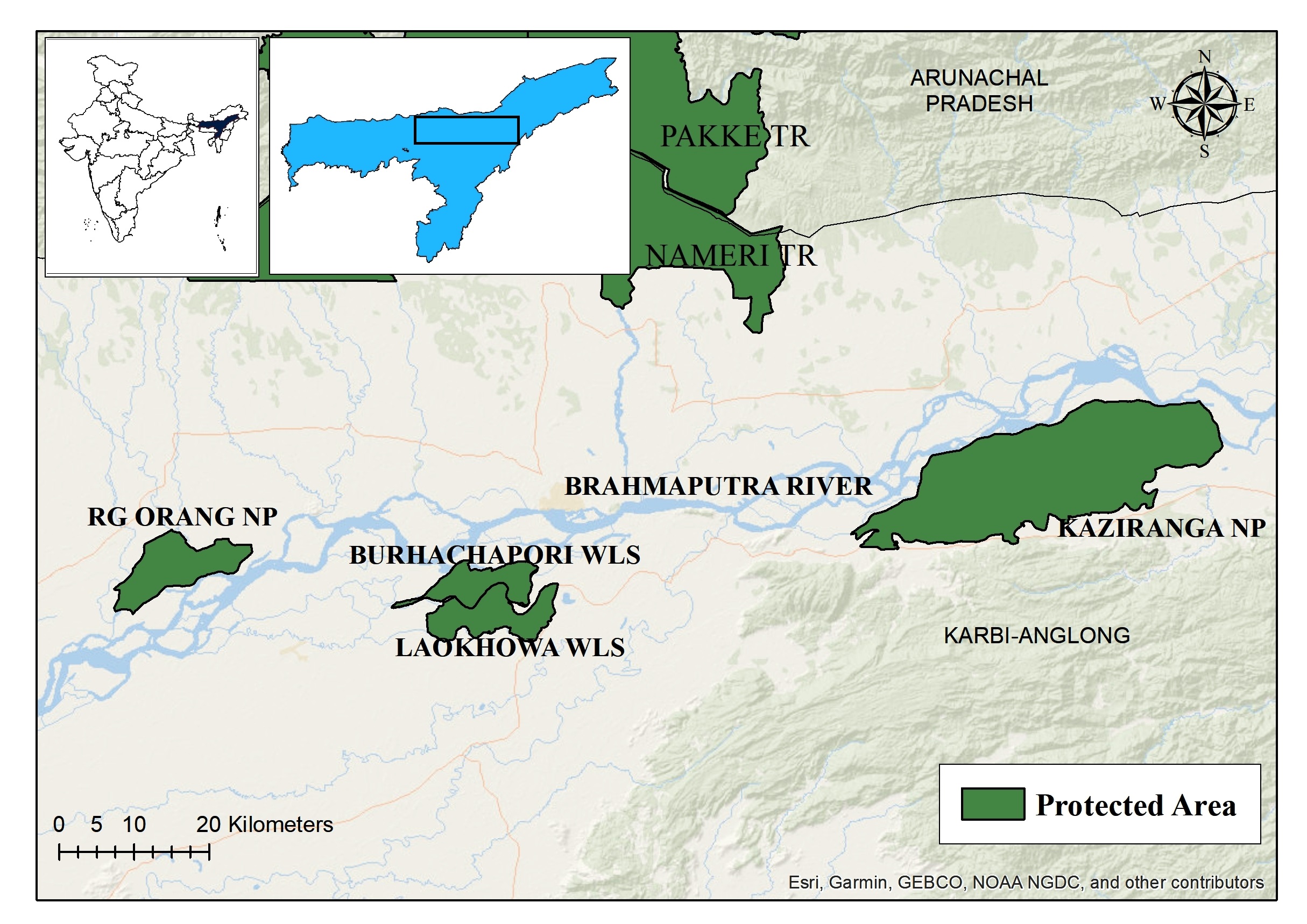Greater one-horned rhino (Rhinoceros unicornis) behaviour during high floods at Kaziranga National Park and the Burhachapori Wildlife Sanctuary, Assam, India
DOI:
https://doi.org/10.69649/pachyderm.v62i.447Abstract
The behaviour of the greater one-horned rhinoceros (Rhinoceros unicornis) (GOH) in response to exposure to natural hazards like floods is poorly understood. This study recorded the behaviour of GOH in highland refuges during periods of seasonal and extreme flooding in two protected areas in the Brahmaputra River valley (Assam, India): Kaziranga National Park (KNP) and Burhachapori Wildlife Sanctuary (BWS). Following the death after monsoon floods in 2016 of a lone sub-adult female translocated to BWS from KNP, the study compared the behaviour of this individual during high flood periods to that of other adults, sub-adults and calves in KNP in 2017. Adult rhinos of KNP spent most of the time resting during high flood periods, which may be a behavioural response to overcome stress. By contrast, both calves and sub-adult rhinos in KNP and especially the lone BWS sub-adult female rhino were observed swimming from one highland to another, despite the heavy floodwater current. Sub-adults in KNP dedicated considerable time to feeding; however, the sub-adult in BWS spent less time feeding than any of the age groups in KNP, and her weakened state from starvation may have contributed to her death after the floods receded. The study concludes by offering recommendations to help rhinos survive and recover from seasonal flooding. Adult animals may be the better choice for future rhino translocations from KNP to other flood plain habitats than subadult rhinos or a mother with calf.
Keywords
Translocation, Indian Rhino Vision 2020, climate change, protected area management, adaptive behaviour
Résumé
Le comportement du rhinocéros indien (Rhinoceros unicornis), suite à l'exposition aux risques naturels tels que les inondations, est mal compris. Cette étude a enregistré le comportement du rhinocéros indien dans les refuges des hauts-plateaux pendant les périodes d'inondations saisonnières et extrêmes, dans deux aires protégées de la vallée du Brahmapoutre (Assam, Inde): le Parc national de Kaziranga (PNK) et le Sanctuaire de faune de Burhachapori (SFB). Suite à de graves inondations de mousson en 2016, qui ont causé la mort d’une femelle subadulte transférée seule au SFB depuis le PNK, l'étude a comparé le comportement de cet individu pendant les périodes d’inondations à celui d'autres adultes, subadultes et jeunes dans le PNK en 2017. Les rhinocéros adultes du PNK, pendant les périodes de fortes crues, passaient la plupart du temps au repos, ce qui peut être une réponse comportementale pour surmonter le stress. Par contre, autant les rhinocéros jeunes que les subadultes du PNK, et en particulier la femelle subadulte du SFB, ont été observés en train de nager d'un haut-plateau à l’autre, malgré le fort courant dû aux inondations. Les subadultes du PNK consacrent un temps considérable à l'alimentation; cependant, la subadulte du SFB a passé moins de temps à se nourrir que n'importe quel groupe d'âge du PNK, et son état d'affaiblissement dû à la famine a peut-être contribué à sa mort après le retrait des inondations. L'étude conclut en proposant des recommandations pour aider les rhinocéros à survivre et à se remettre des inondations saisonnières. Les animaux adultes sont probablement les individus les plus indiqués pour les futurs transferts de rhinocéros du KNP vers d'autres habitats de plaine inondable, plutôt que les rhinocéros subadultes ou qu’une mère avec un jeune.
Mots clés
Translocation, Indian Rhino Vision 2020, changement climatique, gestion des aires protégées, comportement adaptatif.

Downloads
Published
How to Cite
Issue
Section
License
Copyright (c) 2021 Pachyderm

This work is licensed under a Creative Commons Attribution-NonCommercial 4.0 International License.



